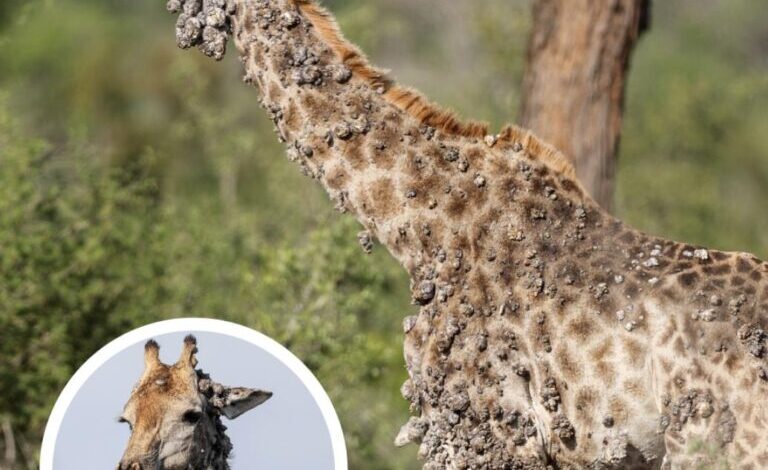Wildlife Disease Discovery: Photographer Documents Rare Giraffe Condition in African Safari

Extraordinary Wildlife Photography Reveals Important Conservation Story
Professional wildlife photographer Helen Olive made a remarkable discovery during her recent African safari expedition in South Africa’s renowned Kruger National Park. What initially appeared to be a typical giraffe photography session evolved into an important wildlife conservation documentation that highlights the complex health challenges facing African wildlife populations.
While capturing sunrise photographs of grazing giraffes, Olive noticed unusual formations covering the animal’s distinctive spotted coat. Through her professional camera lens, she observed what appeared to be bark-like growths extending across the giraffe’s neck and body, creating an extraordinary visual that would later contribute to important wildlife disease research and conservation awareness.
Understanding Papillomavirus in African Wildlife Populations
The remarkable visual documented by Olive represents a papillomavirus infection affecting wild giraffe populations across African conservation areas. This viral family impacts various animal species worldwide, manifesting in giraffes as distinctive keratin-based lesions that develop into crusty, bark-textured formations on the animal’s skin.
These growths consist primarily of keratin protein, similar to human fingernails, but accumulate into substantial masses that can cover significant portions of the affected animal’s body. Wildlife veterinarians emphasize that while these infections appear dramatic, they rarely prove fatal to otherwise healthy giraffe populations.
Dr. Rina Patel, a wildlife disease specialist with South African National Parks Service, explains that viral transmission mechanisms among wild giraffe populations remain under active scientific investigation. Research suggests that oxpecker birds, commonly observed removing parasites from large African mammals, may inadvertently facilitate viral transmission between animals during their feeding activities.
Wildlife Health Management and Conservation Challenges
Healthy giraffes typically maintain natural immunity that limits papillomavirus outbreaks to manageable levels. However, environmental stressors including habitat pressure, nutritional deficiencies, or concurrent health issues can compromise immune system function, allowing viral infections to establish more extensive presence.
The documented case represents a long-term infection based on the extensive growth patterns observed, highlighting the importance of ongoing wildlife health monitoring in African conservation areas. Such documentation provides valuable data for wildlife disease management and conservation strategy development.
Impact on Wildlife Photography and Conservation Awareness
Olive’s photography documentation quickly gained attention across social media platforms and wildlife conservation communities, generating important discussions about wildlife health challenges in protected areas. The striking visual imagery, showing a giraffe that appeared to be developing tree-like bark formations, captured public imagination while raising awareness about lesser-known wildlife conservation issues.
This experience transformed Olive’s approach to wildlife photography, shifting her focus from capturing only pristine subjects to documenting the complete spectrum of wildlife experiences, including health challenges that affect wild animal populations.
Veterinary Management and Treatment Approaches
Kruger National Park wildlife management teams maintain careful monitoring protocols for affected animals using remote camera systems and periodic veterinary assessments. When necessary, field veterinarians can administer antibiotic treatments and apply protective dressings to prevent secondary bacterial infections in compromised lesions.
However, wildlife management protocols emphasize minimal intervention approaches to avoid additional stress on affected animals or disruption of natural herd social dynamics. Veterinary interventions are typically reserved for cases involving severe complications or secondary infections that could threaten animal welfare.
Research and Future Treatment Development
Current wildlife disease research includes vaccine development programs for papillomavirus prevention in captive giraffe populations, with potential future applications for wild animal protection. Veterinary researchers are also investigating topical antiviral treatments in controlled environments, though deployment challenges remain significant for large-scale wildlife conservation applications.
These research initiatives represent important steps toward comprehensive wildlife health management strategies that address both immediate treatment needs and long-term prevention approaches for vulnerable wildlife populations.
Conservation Photography and Wildlife Advocacy
The documented case continues to serve important educational purposes, helping safari visitors and conservation supporters understand the complex health challenges facing African wildlife. Professional wildlife photographers increasingly recognize their role in documenting complete wildlife stories, including health challenges that affect animal populations in protected conservation areas.
Broader Conservation Implications and Wildlife Protection
This wildlife documentation emphasizes that effective conservation strategies must address multiple threat categories beyond traditional concerns like poaching and habitat loss. Understanding and managing wildlife disease represents a crucial component of comprehensive conservation programs designed to support thriving wild animal populations.
The ongoing research and monitoring efforts surrounding this case contribute to growing scientific understanding of wildlife health management, ultimately supporting conservation goals that ensure African wildlife populations can flourish despite various environmental and biological challenges they face in modern conservation landscapes.